
-1-
Every mother of a toddler can attest that just because something shares the color and consistency of chocolate, it does not follow that it is a good idea to put it in your mouth.
But the idealism and inexperience of eleven-year-old-me was intrigued by the Carob cookbook that I found looking brand new at a garage sale (first clue!) that assured me I could create a version of chocolate chip cookies that would be both tasteful and healthful and that “nobody would ever know!” (second clue!) were in fact made with something else. The resulting culinary fiasco made me a lifelong cynic regarding food mimicry and the words “alternative” and “substitute” and “tastes just like…”

And so when Paleo cookbooks began to emerge promising the “same great taste” without the sugar, gluten, dairy, alcohol or tasty toxins—I scoffed. That I should now be writing a positive review of a book titled Paleo Takeout: Your Restaurant Favorites Without the Junk suggests that I was first sipping some sugar-free, toxin-free Kool-Aid. (Spoiler Alert: I ended up giving it 5 stars).
-2-
First, a quick disclaimer. I do not consider myself “Paleo” per se. I don’t really buy the whole “eat like a caveman” philosophy, agreeing with Matt Stone that “the first thing the caveman did when he evolved was to give up the caveman diet!” But I do share a lot in common with Paleo practitioners in terms of limiting sugar and gluten and artificial ingredients, and consuming dairy and alcohol in moderation (at least in theory).
The reasons for this are lengthy and health related. They began with a doctor’s cheery opening sentence “I wish I could tell you that you had cancer…” that led to a lengthy internet search of autoimmune conditions with horrifying symptoms and side-effects [Note to self and anyone who is out there: DON’T!] and finally a foray into the world of natural food remedies and a very short list of “Green as in Go” foods (most of them also green, and which made me green with envy toward anyone who could eat “real” food).
[BTW: I am actually quite healthy these days, but have learned that eating this way keeps my energy up and my weight down, so I continue to do so usually at least some of the time.]
-3-
This video pretty much tells the story of the melancholy that pervaded my first few months on this diet:
Keep in mind that the original song it parodies is from a show aptly titled Les Miserables that centers around a man imprisoned and hunted for stealing bread, and you’ll begin to get the idea.
-4-
That being noted, I am in retrospect grateful that my initial diet was even stricter than Paleo, and did not allow for substitutes that Paleo preachers promise are “just as good as the real thing.” Strict abstinence made my taste buds fonder of the natural sweetness even in vegetables. (Or just killed enough brain cells to delude me into thinking this—you decide).
I quickly found that the way to happiness was not in a Paleo pretend version of a favorite, but actually in real food. Real steak, the kind that melts in one’s mouth. Real yogurt (I was allowed this! Paleo puritans still eschew it) the full fat creamy kind, a serving of which would have been 25% of my Weight Watchers calorie points for the day. Real, fresh vegetables with real butter or olive oil. Lamb chops marinated with fresh lime juice and rosemary. Whole roasted chicken. All the things that our grandmother’s generation ate but that our mother’s generation was told would give us heart disease and make us fat.
But of course there was still a longing for some of my old favorites–pizza, Buffalo wings, Chinese takeout. When Russ Crandall (a.k.a. The Domestic Man) proposed “real food” versions of these in his new cookbook, I wondered if such a thing was really possible or merely what they say about second marriage or being a Mets fan–the triumph of hope over experience.
-5-
This lengthy lead-in helps me to say that the biggest pros of this book are that its recipes are good in their own right, and in most cases worthy of serving to non-Paleo company!
Some recipes are spot on or even better than restaurant versions I have tried! His wings may be the best I have ever had, eliminating future Styrofoam containers from Atomic Wings, which will no doubt make Pope Francis happy (even if it kills my hope for a fairy tale ending). Wings themselves can be close to Paleo if using a sugar free sauce with simple ingredients (i.e. with names that don’t read like an Old Testament genealogy) but even then most take-out is fried in canola oil (which in the Paleo religion is the new Satan). So I had given up on the juicy crispness of fried wings until this recipe, which on its own makes the book worth buying. (And which brings to light the book’s only serious omission: a Paleo blue cheese dressing to dip them in)!
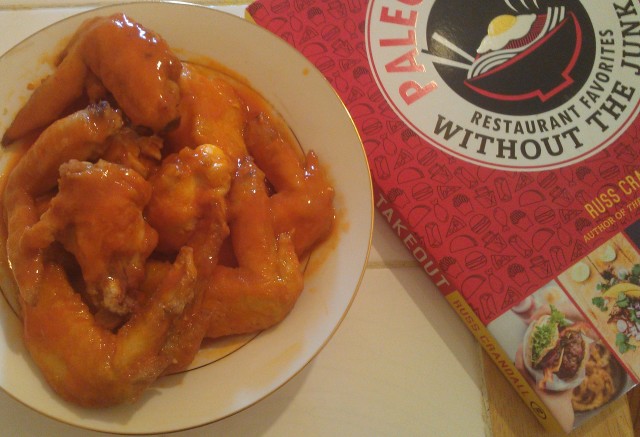
I was hesitant to try the gluten-free pizza, having had almost universally bad experiences of any gluten free bread product, even in NYC restaurants, but it was incredibly good, and super easy! No, it doesn’t compete with traditional NYC pizza (nor does the pizza in Italy, for the record) but beats hands down any gluten-free version, even those of the finer NYC establishments. The crust is crispy and chewy (in a good way!) and I ate the whole thing, despite being that weirdo that usually leaves the crust for someone else. No, it does not taste like traditional crust–if you prefer Sicilian or Chicago deep dish style you may find it disappointing. But I loved it enough to make it three times in two weeks, even heating the oven to 500 degrees (and with outside temps in the 90’s, that’s saying something)! [And I am glad to note that on this page Russ knows better than to indicate a serving size, because this is too good to be shared…]
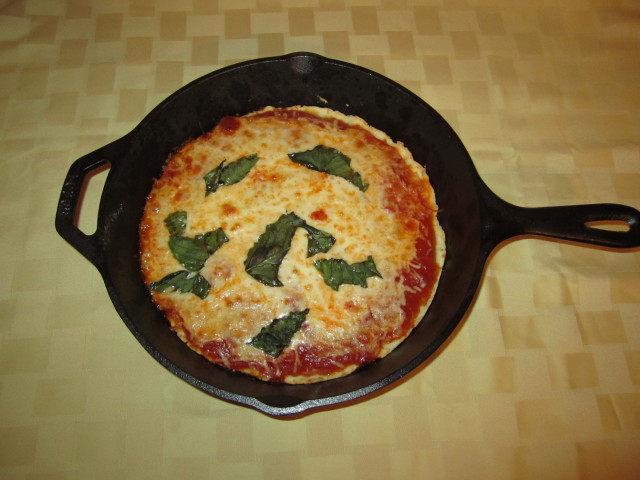
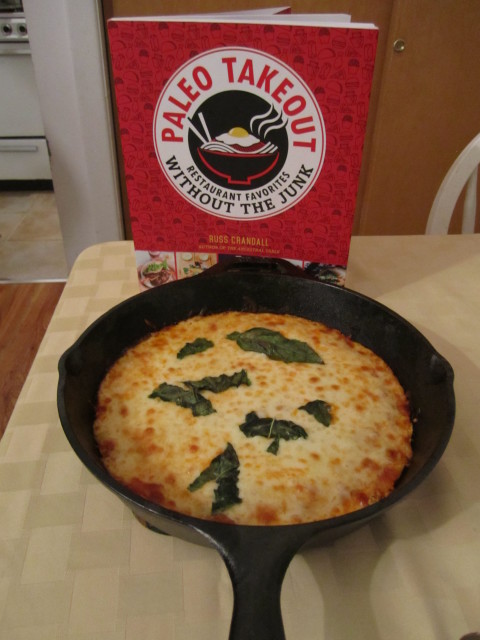
We had a Gyro making party at a friend’s house last week, and the UPS guy stopped by to sample one and rated it an A+! These included homemade Tzatziki sauce (made with homemade mayo); homemade flatbread (made with plantains) and homemade gyro meat loaves and Greek salads. We also tried the Chicken Tikka Masala (yeah it doesn’t match but whatever) and non-Paleo Mojitos with the extra fresh mint leaves and a few other ingredients that we won’t admit to.

A note on the flatbread–it does not taste like pita or typical flatbread; it does taste better! At first when we tried it on its own I was nervous, because while tasty it was “different”–chewier and a little sweeter. However, when it actually was used in the assembled gyros the flavors were a perfect marriage! And its consistency held together better than traditional pita/flatbread–I can only say it is an improvement over the “real” thing.

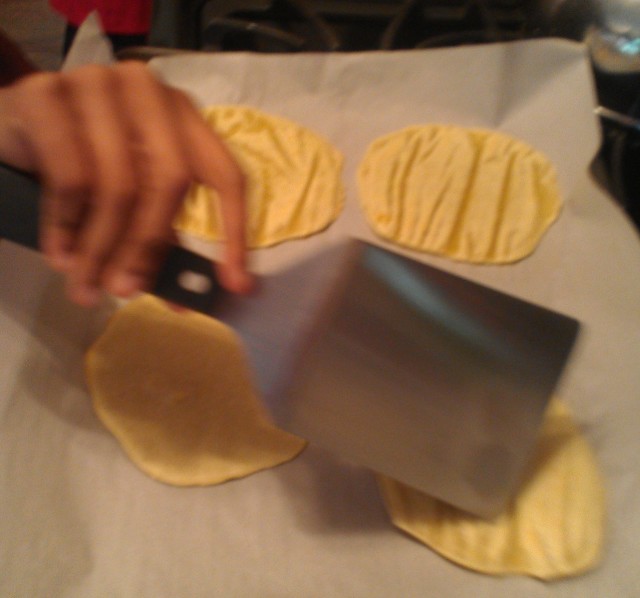
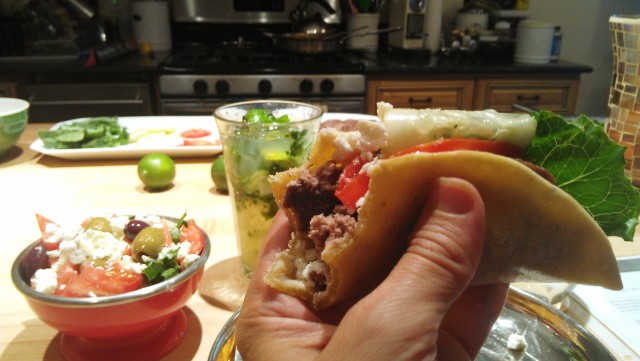
I’ve also made his Eggplant Parmesan (including an Italian Grandmother-worthy homemade sauce), Chicken Nuggets, Mongolian Beef, and General Tso’s chicken–all delish.
Their proximity to the “real” thing though will vary according to recipe and also to the expectations of the person trying it. I would say that the savory recipes tend to taste most authentic, while those normally sweeter are best for those who have been eating a Paleo type diet for a while and so are weaned off excessive corn syrup and deep fried breading. If you have typical takeout General Tso’s chicken just before sitting down to Russ’s, you may possibly be a little disappointed. But if you gave that up long ago, and you sit down to a dish of something with no expectations, you will pleasantly recall it as tasting similar. (And because it made with “cleaner” ingredients, you will not be hungry and/or calling on Saint Grace 20 minutes later…). The Mongolian Beef, for example, did not taste to me that close to the restaurant version, being not nearly as sweet, but I actually preferred it Russ’s way and felt much better afterward.
-6-
The term “take-out” may carry certain connotations that should be discussed: for many it translates to mean a meal that is quick, easy, and cheap. Paleo Takeout is none of those things. Keep in perspective that this book is named for a demographic whose meal preparation began with meat that still had a pulse, and you’ll be more satisfied with the actual work and time involved.
That being said, the cookbook has a timing section which is super helpful if at times somewhat optimistic. (I think it is accurate for experienced cooks, but the first time making something will take you a little longer than the recipe allows, so keep that in mind). Many meals can be made in an hour; if you are used to cooking big meals for a family or cooking the old-fashioned slow way, you might find these shorter–though if you are reading this blog and are not related to me, chances are high that you live in NYC and don’t cook like that more than once a year. Some others are in fact pretty quick, such as the pizza recipe which I’ve made a few times since the book arrived. (The pizza crust also freezes nicely, if you don’t eat it all in one sitting). Something like the Chicken Tikka Masala by nature should be marinated overnight and cooked slowly to bring out the flavors–so not fast food, but superior otherwise to local takeout. And some, like the gyros or the Korean fermented specialties, require multi-level preparation over days but are still worth it for final taste and authenticity!
You will also have to put on your hunter-gatherer hat and get some rather strange ingredients: arrowroot or tapioca starch, mirin, coconut aminos, lard, white pepper. The great thing is Russ has set up an Amazon shopping list for the lazy. Or you can try Wegman’s or Whole Foods (don’t let them overcharge you!) or ethnic specialty shops. Some of these are a little expensive, but after an initial outlay you will find that you are able to make many different meals with them (so my vote = worth it). He also favors real ingredients such as fresh spices and the tastier but more expensive cuts of meat. You can go with dried or cheaper but will compromise taste. Likewise, the more obscure Asian spices will taste more authentic than the easier substitutes, but you can get away with either.
And you may find yourself investing in some new kitchen equipment, such as this cast iron pan which set me back a mere $25 but is now my new BFF, second only to my coffee pot. If polygamous marriages to appliances are ever legalized, I will put a ring on both. Seriously–the cast iron pan is a key element to the greatness of the pizza and the wings in particular!
-7-
Some final notes:
This book is a godsend for anyone following the Paleo diet or any variation of it, and still worth it for those who are not but who may wish to limit sugar and/or grains. He has also written adaptations for those following AIP (Auto-Immune Protocol) and Whole-30 which can be found here.
This book is NOT for the fat-phobic, vegans, vegetarians or Paleo Puritans, though the latter can easily adapt recipes to their wishes following Russ’s handy substitution guide. Russ is part of the Perfect Health Diet camp of Paleo that allows for some things purists might scorn, including limited dairy (mostly butter and yogurt) and “safe starches” including rice and potato, and he makes the case for these in the book, along with an explanation of the basic science behind his diet choices. He also includes some sweeteners such as honey, but again options to sub in applesauce if you are insane so wish.
This book does NOT include desserts, which I think is a credit to Russ. (See Take 1 if you’ve forgotten). He also wisely writes to “omit” cheese if you can’t have the real thing in most recipes, though compromises with an almond cheese recipe for the desperate, and in some cases will accept the substitution of nutritional yeast.
You can find the list of recipes in the book here and a general description here.
You can find the book on Amazon (with my condensed review here) or at Barnes and Nobles, and BJs if you are a member.
Final rating:

The Domestic Man = The Domestic Magician!
Non Disclaimer:
I discovered author Russ Crandall, a.k.a. The Domestic Man and author of The Ancestral Table when I was first searching for “real food” recipes without sugar and gluten. His recipes were not pretend versions of contemporary foods but rather went back to the original highly flavored good things that were served up in the “good old days” before margarine and canola oil.
So, when Russ began to promote his idea of a new cookbook, Paleo Takeout, I was a little more willing to listen and give it a try. In a brilliant marketing strategy, he invited Facebook followers to test out a recipe or two and give feedback during his writing process. I was one of the testers, and then by lottery won a pre-release version of the cookbook to review for Amazon.
No other disclaimers necessary because I don’t know Russ and don’t get paid even 1 cent for my feedback or links to his pages! 
Linking up with Kelly for Quick Takes Friday. Visit This Ain’t the Lyceum for more Takers!

This is such a great blog entry. I had to read it again! The video is absolutely hilarious too. By the way, the recipes that I have tried from that book are really really amazing!
The video is absolutely hilarious too. By the way, the recipes that I have tried from that book are really really amazing!